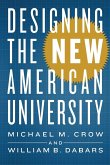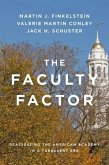America's research universities consistently dominate global rankings but may be entrenched in a model that no longer accomplishes their purposes. With their multiple roles of discovery, teaching, and public service, these institutions represent the gold standard in American higher education, but their evolution since the nineteenth century has been only incremental. The need for a new and complementary model that offers broader accessibility to an academic platform underpinned by knowledge production is critical to our well-being and economic competitiveness. Michael M. Crow, president of Arizona State University and an outspoken advocate for reinventing the public research university, conceived the New American University model when he moved from Columbia University to Arizona State in 2002. Following a comprehensive reconceptualization spanning more than a decade, ASU has emerged as an international academic and research powerhouse that serves as the foundational prototype for the new model. Crow has led the transformation of ASU into an egalitarian institution committed to academic excellence, inclusiveness to a broad demographic, and maximum societal impact. In Designing the New American University, Crow and coauthor William B. Dabars--a historian whose research focus is the American research university--examine the emergence of this set of institutions and the imperative for the new model, the tenets of which may be adapted by colleges and universities, both public and private. Through institutional innovation, say Crow and Dabars, universities are apt to realize unique and differentiated identities, which maximize their potential to generate the ideas, products, and processes that impact quality of life, standard of living, and national economic competitiveness. Designing the New American University will ignite a national discussion about the future evolution of the American research university. "A brilliant, innovative, lucid, and path-breaking book--arguably the most significant book on higher learning since Clark Kerr's The Uses of the University, published more than a half-century ago."--Jonathan R. Cole, author of The Great American University: Its Rise to Preeminence, Its Indispensable National Role, Why It Must Be Protected "We must remember that the connection of excellence and access is not just a slogan but a necessity for all of us in higher education. That was the special genius of California's master plan: attempting to forge and maintain connections at every level between teaching and research. The plan requires updating, with more emphasis on serving diverse populations of students, and continued expansion and innovations. Crow and Dabars may not have reinvented the master plan, but they have made an important intervention in the debate about which models work best, for which purposes and constituencies, and how we can support those models at the scale they require, all while maintaining academic rigor and autonomy."--The Chronicle Review "Crow and Dabars offer a close analysis of the history and values that spawned our world-renowned research facilities and present a fresh model characterized by a pragmatic research structure and transdisciplinary organization . . . The authors present a dense and extensively investigated explanation of the strengths and limitations of our contemporary higher education environment and the possibilities of a new model."--Library Journal "An engaging and readable justification for and account of the New American University project . . . Crow is unlikely to disappear from view for quite some time."--Times Higher Education "Crow and Dabars are right to want new public universities to replace the Harvard standard. Their book is worth reading just for that discussion."-- Los Angeles Review of Books "Crow . . . continues to be at the cutting edge of these and other challenges, opportunities, and initiatives for public research universities in general and his own institution in particular . . . Well written and laden with notes and bibliography, this is a solid complement to William G. Bowen and Eugene M. Tobin's Locus of Authority (2015) and Robert Lacroix and Louis Maheu's Leading Research Universities in a Competitive World (2015)."--Choice "It is impeccably referenced and thoughtfully paced with detailed chapters building the model they support. Within the book is a trove of information on the trajectory for and challenges facing higher education. Whether one chooses to follow the prescription they suggest, or simply wants to better understand higher education, this book provides a most compelling read."-- PsycCRITIQUES "Dabars' rich historical contextualization and Crow's policy and managerial experience provide design principles encouraging institutions to leverage their own place in a locally appropriate way."--Nature "The New American University is the latest bold and meticulously argued model to reclaim what is distinctively American in higher education."-- Journal of College and University Law








